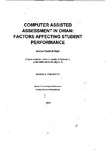COMPUTER ASSISTED ASSESSMENT IN OMAN: FACTORS AFFECTING STUDENT PERFORMANCE
| dc.contributor.supervisor | Ricketts, Chris | |
| dc.contributor.author | Al-hajri, Amina Obaid | |
| dc.contributor.other | School of Geography, Earth & Environmental Sciences | en_US |
| dc.date.accessioned | 2011-04-06T15:17:38Z | |
| dc.date.available | 2011-04-06T15:17:38Z | |
| dc.date.issued | 2011 | |
| dc.date.issued | 2011 | |
| dc.identifier | 10093887 | en_US |
| dc.identifier.uri | http://hdl.handle.net/10026.1/318 | |
| dc.description.abstract |
This thesis investigates the social and psychological factors that might affect Omani higher education students if computerised assessment was to be implemented. A review of the literature and the historical and cultural development in Oman suggested that a number of different variables might affect students‘ performance when taking computerised assessment. These factors which include gender, college of study and geographical region of residence may cause unwanted and selective differences in student performance which are not related to the content of the assessment. In addition, the potential effects of such variables as computer experience and computer self-efficacy on student performance were investigated. The study also explored student and academic staff attitudes towards computerised assessment. Both quantitative and qualitative methods are used in this study through a selection of instruments such as a test that was delivered in different modes, questionnaires, focus groups and semi-structured interviews. Quantitative approaches are used to provide answers to the main study questions about student performance, and qualitative approaches are used to get deeper insights into the students‘ and staff members‘ perceptions, attitudes and values in relation to the research subject of the study. All these instruments were developed based upon the literature and also validated through a separate initial study. The main study took place after the instruments had been validated and involved over 400 students and 100 staff at three Omani Applied Sciences Colleges. Statistical analysis showed a small but significant difference between the two assessment modes in favour of the paper-and-pencil test. There was a significant difference in performance between both genders, with females out-performing males. However, the most striking finding was a differential effect of assessment mode between males and females. Males performed better in the computerized test than in the paper-based one, in contrast to females whose performance in the paper test was better. This suggests that the introduction of computerised testing may affect males and females in different ways. One 4 possible explanation for this is that Omani males have more opportunities to use computers inside and outside homes. The questionnaire results and the qualitative information from focus groups both showed that females were more nervous and found it more difficult to read from the computer screen than males did. Also, it was obvious in the focus group discussions that females had more negative feelings towards computerised testing compared to males, both before and after experiencing computerised assessment. The study found that students‘ performance in the English language test had showed significant variation across colleges, and among students from different regions. This variation seemed to be associated with variation in computer experience among students at the different colleges and from different regions. This may be due to regional differences or specificities, especially in terms of computer use, among the nine administrative regions in Oman. Staff attitudes and perceptions towards CAA, in general, were positive and not affected by either the gender or nationality/language factor. Most of the academic staff members revealed their willingness to implement CAA but also stressed that CAA should be gradually implemented. Both students and staff members identified a number of important points such as the need for a reliable system, qualified technicians and sufficient computers if Computer Assisted Assessment was to achieve wide acceptability. | en_US |
| dc.description.sponsorship | Ministry of Higher Education | en_US |
| dc.language.iso | en | en_US |
| dc.publisher | University of Plymouth | en_US |
| dc.subject | Computer self efficacy | |
| dc.subject | Computer Experience | |
| dc.subject | Gender Difference | |
| dc.subject | Attitudes | |
| dc.subject | Computer Assisted Assessment | en_US |
| dc.title | COMPUTER ASSISTED ASSESSMENT IN OMAN: FACTORS AFFECTING STUDENT PERFORMANCE | en_US |
| dc.type | Thesis | |
| dc.identifier.doi | http://dx.doi.org/10.24382/1496 |
Files in this item
This item appears in the following Collection(s)
-
01 Research Theses Main Collection
Research Theses Main


